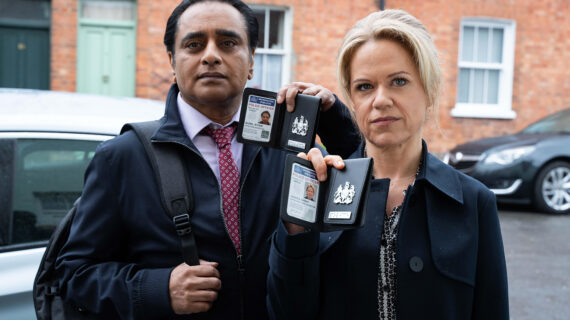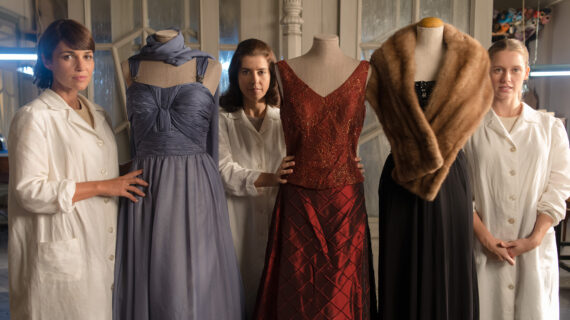[Jim Lattis, Director, Space Place, University of Wisconsin-Madison]
Okay, good evening and welcome to Space Place. This is our guest speaker night, and I’m very pleased to introduce tonight, Dr. Lisa Ruth Rand, who is a postdoctoral researcher here at the university. She has an appointment at the Institute for Research and the Humanities and came here from the University of Pennsylvania where she received a PhD in the history of science. So tonight, we’re going to talk a little bit about the history of space junk. So, help me welcome Ruth Rand.
[applause]
[slide titled, Space Junk, with the accompanying definition as – an object made by humans for use in outer space that no longer serves a designated purpose or use, it may remain in space or return to Earth through the atmosphere. The slide additionally has three photos – one of a space satellite, one of a bunch of screws, and one of a solid rocket booster detaching from a spaceship]
[Lisa Ruth Rand, Postdoctoral Fellow, Institute for Research in the Humanities, University of Wisconsin-Madison – off camera]
Okay, great, so, space junk.
So, in official policy held by N.A.S.A. and other space organizations, space junk is defined as anything that’s designed and created by human beings specifically for use in outer space that no longer serves a designated purpose or use. This can include objects that remain in space and objects that are returning to Earth through the atmosphere. These are two distinct kinds of space junk, which we will – we will be looking at both of those tonight.
So, what does this include? It can include things like dead satellites. Satellites that we’ve launched that have run out of fuel, that never worked in the first place, but that remain in space not providing information to the ground. It can be pieces of things that put our satellites and other spacecraft into space, like pieces of rockets that launched those satellites.
[Lisa Ruth Rand, on camera]
It can be lens caps popped off of space telescopes or surveillance satellites, but also smaller things like errant screws or flecks of paint. Things that are shed over the course of normal operations of spacecraft.
So, space junk is produced as a result of rocket launches, satellite operations, and even satellite litter, astronauts, I’m sorry, astronaut litter. So, astronauts have dropped things, either intentionally or unintentionally, ranging from tool bags, pliers, spatulas, cameras, and even gloves.
So, this is the very first America spacewalk. You can see Ed White up in the corner here walking in space.
[a red arrow appears in the video pointing to a space glove that flew out of the door during the spacewalk]
And that is an extra glove that flew out of the door in the middle of his spacewalk in 1965 on Gemini 4. And it was tracked by sensors on the ground until it eventually reentered the atmosphere and burned up.
[laughter]
[new slide with a photo from Tranquility Base on the Moon with a yellow arrow pointing to a jettison bag sitting on the surface of the Moon near the landing module]
We’ve even left waste behind on the moon. Now, this is actually the very first photograph that Neil Armstrong took on his first full spacewalk on the moon in July 1969. You can see the leg of the Eagle lunar module in the background there, and what’s underneath it is this white bag called a jettison bag, or a jet bag for short. And these jettison bags were commonly used on – on Apollo missions. They contained a lot of things that astronauts no longer needed, included human waste.
So, what’s interesting about these is that they left quite a few of these jet bags on the surface of the Moon, and those objects will remain up there indefinitely, so there’s quite a bit of human poop on the Moon that’s going to stay up there –
[laughter]
– much longer than human beings may – may survive on this planet. So, and in a later mission actually, astronauts even threw one of these jet bags out of the window during a return trip to – to Earth, and they sent it off with a fond “Bye-bye, bag!”
[return to the slide with the photo of Tranquility base, now with a speech bubble emanating from the jet bag saying, Bye-bye, bag!]
So, space, including the Moon and orbit, is like any other place that human beings have visited. Where humans go, we create waste, and we’ve made a lot of it over the course of the past 60 years.
[new slide with an animation of the Earth as seen from space with all the space junk in orbit signified by yellow dots floating around the planet – the animation covers the years from 1961 to the present and one can visually see the large increase in space junk/yellow dots over the years]
So right now, there’s some 1,100 working satellites in orbit at the current moment. And the rest of the objects that you’ll see growing over the course of time in this animation, the rest of these objects are non-functioning space junk. And as of April, of this year (2018), there are a total of some 18,922 cataloged human-made orbiting objects tracked by the U.S. Space Surveillance Network. But the Orbital Debris Program Office run through N.A.S.A. puts the total number of objects larger than 10 centimeters in orbit at around 21,000. And this doesn’t include small debris. So, particles between one and 10 centimeters in diameter, they estimated about 500,000 in orbit right now. And particles smaller than one centimeter, a number in excess of 100 million.
[male audience member, off camera]
Oh, geez!
[Lisa Ruth Rand, off camera, with the animation reaching the 2000s]
So, we have all this stuff up here, up in space, but what is it doing? Is – is space junk dangerous?
[new slide titled, Hypervelocity Impact, with a video from the European Space Agency showing the large damage done to a piece of metal by a smaller b-b shaped piece of metal]
So, objects in space, especially in orbit, are moving at very, very quick speeds, so particularly in lower orbits, objects can travel anywhere up to seven or eight kilometers per second. So, even an object that’s very, very small, this is a – this is a simulated orbital collision that was taken – that was – that was demonstrated by the European Space Agency recently. Even objects very small can have a – can pack a real punch moving at – at velocities of seven or eight kilometers per second.
An analogy that’s used by N.A.S.A. is that a piece of debris smaller than a half an inch around –
[Lisa Ruth Rand, on camera]
– like the object shown here, traveling at about six miles per second could hit as hard as a bowling ball traveling at 300 miles per hour. So, it can have a really devastating effect on functioning spacecraft, on – on spacecraft that we’ve spent millions or even billions of dollars sending up into space and want to protect.
Now, I don’t know, hopefully some of you have seen or saw the 2013 movie Gravity –
– in which Sandra Bullock gets kind of walloped by debris and learns to hate space. And in this movie, spoiler alert, space junk is the enemy. And the biggest threat – and I’ll move on from this animation quickly ’cause it’s kind of dizzying – the biggest threat in Gravity is to astronauts’ bodies, right? These uncommonly beautiful astronauts. The – the concern is, will they survive with all this space debris traveling at, you know, at – at seven or eight kilometers per second?
So, this scenario in Gravity, can it happen?
Well, not exactly as it happened in the movie.
I’m going to try to, here we go. So, not exactly as it happened in the movie, but collisions in space –
[new slide with an animation of a space collision between an American satellite, Iridium 33 and a Russian satellite, Cosmos 2251 along with the predicted space debris trajectories after the collision]
– have started to happen with, accidental collisions in space have started to happen, and intentional collisions in space. Now in 2009, this animation shows the very first head-on accidental collision in orbit between a functioning American Iridium satellite and a non-functioning Russian satellite. And these two collided over Siberia and created two large plumes of debris circling the globe over their former orbital paths. And so, the collision, again, destroyed both – both satellites and created large, new plumes of debris. This came on the heels of an intentional debris-causing event when China, in 2007, attempted to bring down one of its own defunct weather satellites and accidentally, instead of bringing it down cleanly, destroyed it and created a whole other plume of debris.
So, you can see here, this is a – this animation shows the debris caused by that 2009 accidental collision mixing with all of the other objects, both functioning and non-functioning, that are currently in orbit.
So – so, yes, this kind of cascading collision creating debris can happen, the kind – of the kind that was shown in Gravity, but not at that sort of instantaneous moment that it happens in Gravity, and not at all orbital altitudes as happens in that movie.
[new slide with a photo of damage done to the International Space Station by space debris]
And we have evidence that astronauts are, indeed, you know, threatened by space debris that’s currently in orbit. This is an image taken in 2016. This is a pit in the window of the cupola of the International Space Station. Now, the astronauts are fine. There’s multiple layers of glass. They’re safe. But you can see here, this is kind of a catastrophic-looking little like impact crater caused by a small piece of debris.
And so, and – and it happens occasionally that astronauts do in fact have to take shelter in either more heavily shielded parts of the space station or have to take shelter in the Soyuz module if theres – if the space station has a close encounter with a piece of debris or – or may have a close encounter with debris.
So, the, you know, the main threat in Gravity, the movie – the fictional movie Gravity, is definitely something that, on a much smaller scale, is taking place currently in space, this – this threat to human bodies, to astronauts’ bodies, but not in the same sense in Gravity where an entire infrastructure, which I’ll get to in a little bit, an entire infrastructure is taken down –
[Lisa Ruth Rand, on camera]
– within seconds, within minutes, by a debris event.
And I want to, before we move on, I want to look at one moment from that movie to kind of bring us in a little more closely –
[slide with a portion of the script from the movie Gravity – MISSION CONTROL – Its not good. Most of our systems are going down. Debris chain reaction is out of control and rapidly expanding. Multiple sats are now down and they keep falling. MATT KOWALSKI – Define multiple sats. MISSION CONTROL – Most of them. Telecommunications systems are gone. MATT KOWALSKI – Half of North America just lost their Facebook.]
– to think about the threat from debris. So, there’s this moment in Gravity where the astronaut played by George Clooney is speaking to Ground Control, and he finds out that apparently most of the all the satellites in space are gone, just gone. And Matt Kowalsky, the astronaut played by George Clooney’s response is pretty – pretty glib. “Half of North America just lost their Facebook.”
Okay, of course with what’s happened recently with Facebook and information, I think a lot of people may think that’s actually a good thing –
[laughter]
– but in 2013, this – this seemed like a really, you know, this seemed like it was both glib but also, you know, kind of scary. Now, that said, this is again very, very flippant.
[Lisa Ruth Rand, on camera]
What’s happening on the ground if we were to lose all of our satellites would be very, very, would be much, much more devastating than just losing Facebook.
So, I want to ask, how many of you have used a satellite today?
Everyone should be raising their hands. I see a few of you aren’t, but everyone should be. So, there are some obvious products that – from satellites that many of us use, many of us in America and Wisconsin use every day. Whether the things that are more obvious, like satellite television or satellite –
[new slide with the logos for Dish Network, Direct TV, and Elvis show – Aloha from Hawaii on the left side]
– that’s by the way, satellite television is much older than kind of these recent consumer products. This Elvis “Aloha from Hawaii via Satellite” from – from the – I believe this is early ’70s based on his outfit. You know, this is, satellite television has – kind of has been a big kind of exciting idea for a long time.
[slide animates on the logos for Sirius Satellite radio and XM satellite radio to the right of the television logos]
Satellite radio is another consumer product that a lot of people use.
[slide animates on a photo of a Garmin G.P.S. unit underneath the radio logos]
But, and some of you may have, not everyone has this anymore, but you may have had a G.P.S. unit that helps you navigate –
[slide animates on three versions of G.P.S. phones to the right of the radio logos]
– or you may have used a satellite phone if you’re in a more remote area.
[slide animates on several smart phone cellular phones below the G.P.S. phones]
But even if you’ve used your – your smartphone or any sort of a cellphone, not even a smartphone, a regular cellphone.
[slide animates on an advertisement for bank A.T.M.s underneath the G.P.S. and smart phone images]
If you’ve ever engaged in banking – you can see this is just an ad –
[slide animates on an image of an A.T.M. over the newspaper article and in-between the Garmin G.P.S. and the smartphone images]
– but even if you’ve used an A.T.M., any sort of financial transaction.
[slide animates on a radar weather image of Wisconsin over the top of the image of the A.T.M.]
If you’ve consulted an advanced weather forecast –
[slide animates on a satellite image of crop land over the image of the newspaper clipping]
– if you’re involved with agriculture, or if you consume products of agriculture, which we all do, that’s –
[slide animates on four satellite images of the Fukushima nuclear plant disaster over the photos of the satellite television logos]
– something that’s tied to satellites. Disaster relief, these are images from the Fukushima disaster of 2013.
[Lisa Ruth Rand, on camera]
If you use an airplane, the entire civil air infrastructure is now being increasingly tied into satellites. If you’ve used Wi-Fi at any point today, you’ve used a satellite. Basically, anything that uses time and location switching is often tied particularly to G.P.S. satellites, but all of these products, whether they’re consumer products, individual consumer products that you and I might use every day, or information that’s required by our – by our defense communities or by agriculture or by any number of different – different industries or communities in America and around the world, so much of what we do every day is tied into satellites. And we don’t really think about it all that often. Kind of one of the few ways that it’s visible on a day-to-day basis is the occasional sighting of a satellite dish.
[return to the slide with all the logos now with a large photo of satellite dishes on the top of an apartment building now in the center covering the multiple other images]
But really, what would happen if all of these services –
[slide animates off all of the images to a plain, black slide]
– just suddenly disappeared?
We would be in some major trouble. And it wouldn’t be something that we would necessarily notice –
[Lisa Ruth Rand, on camera]
– right away. So, satellites, in many ways – I like to talk about satellites as being part of an infrastructure. Now, when we think about infrastructure, we can – another example would be the electrical grid, for instance, or the sewage system. Infrastructures are technological systems that provide the backbone of daily, smaller technological practices that – and these infrastructures provide that support in a way that becomes invisible, in a way that we don’t notice it until it fails. So, we don’t think necessarily about the electrical grid until the lights go out, and then suddenly you think, “Oh, the lights are off, something’s wrong. I can’t use my electronic devices, something’s wrong.” The sewage system fails, things get really exciting then. But we don’t think about them when we flush the toilet. It just – it just happens.
And the satellite infrastructure, in many ways, is even more invisible because I just showed you all of those different kinds of services that are provided that – that rely on satellites to relay information, but if all the satellites were to fall out of the sky at once like they do in Gravity, we wouldnt necessarily – it wouldn’t be like the lights going off. It wouldn’t be something we would see right away. We would almost feel it in our bodies that something was wrong. Things aren’t working the way that they’re supposed to. Our calls get dropped. We can’t navigate using our phones like – like we’re accustomed to. You know, we can’t get money out of the A.T.M. You can’t – your – your – your – the Internet wouldn’t be working quite right. Things would just stop functioning in a way that was completely invisible. And it would be pretty chaotic, I – I imagine, should such a – such a scenario happen.
Now, that said, space policy analysts, both in America and elsewhere in the world, are very concerned about what space junk might do to our critical satellite infrastructure in space. Many of them think that this is a very recent problem and the product of either negligence or ignorance on the part of the American and Soviet space programs during the ’60s and ’70s.
And as a historian, this is something that I’ve been trying to get at the base of for – for some time now, and what I’ve found is that space junk is a much, much older problem, and really, we’ve been aware of it since the beginning of the Space Age. Since Sputnik 1, the very first satellite –
[slide with titled, Sputnik I 1957, with an image of the Sputnik satellite on it]
– that reached space, the very first artificial satellite that the Soviet Union launched into space in 1957.
Now what’s kind of interesting about Sputnik is, and some of you in – in the audience may be old enough to remember when Sputnik launched. Some of you maybe even tried to go outside and look up and see Sputnik with your own eyes, and many people were able to do so. Now I don’t have an image of that, it’s very hard to find video of – of the actual object moving through the sky –
– but I did take a video in Philadelphia two years ago of the International Space Station going overhead, and hopefully we can see this.
That’s the International Space Station, that little star there. And that’s –
[another orange arrow animates on the video pointing to and labelled Jupiter]
– thats Jupiter, just – just for kind of for scale – not for scale but for –
[laughter]
– obviously, but so you can see what I’m looking – well, to show the relative motion. So, when those who went out to look for Sputnik with their own eyes would have seen something a little like this. They would have seen what looked like a moving star crossing the night sky. And you can hopefully see here that International Space Station. Do you see it moving through the sky relative to Jupiter? So that’s what – this – this I took this in – in the early evening when the dark – when the night sky was dark, but the sunlight was still traveling enough around the Earth that it illuminated this object and -and made it appear shiny against the dark background of space. So, those who went out and looked for Sputnik would have seen something like this –
[Lisa Ruth Rand, on camera]
– and some of you may have actually done that.
And now I’m about to ruin your childhood and tell you that that was not in fact Sputnik that you were seeing. So, Sputnik itself was only about the size of a beach ball. Even though it was polished to a very high shine –
[slide with two images – one of a scientist working on Sputnik (for scale) and the other an illustration of the rocket that delivered Sputnik into space]
– it would not have been visible to the naked – it would not have been visible to the naked eye from the ground. You would have needed at least binoculars, if not a specialized telescope, to see it. However, the rocket that launched into space was a good 20 meters long, and the Soviet engineers realized that Sputnik itself would not be visible to the naked eye and instead decided to rig up the core of the rocket that launched into space with reflective prisms that would catch more of that sunlight going around the curvature of the Earth and illuminate it and make it much more visible from the ground. This wasn’t a secret. A lot of American newspapers published that you could go outside and see Sputnik’s companion, Sputnik’s rocket companion in outer space crossing overhead at this place and time. But for whatever reason, we’ve kind of engaged in a collective act of forgetting. What we were actually seeing was a piece of space junk, perhaps the first piece of space junk.
Now does it matter? Not really, right? Whether it was a piece of the rocket or this object with the trailing mustaches coming off the edges, it didn’t matter. Either way it was showing that the Soviets had gotten there first and would inspire either fear or pride depending on your political affiliations. What it really did was provide, you know, regardless of what you were seeing, this was the first encounter that most human beings had with outer space and with the beginning of this – of this time period that we now think of as the Space Age.
[new slide titled, Project West Ford 1958-1963, featuring a photo of an extreme close up of a thumb with tiny fibers on it that are in actuality nanosatellites]
Now Sputnik was only the very first, Sputnik and Sputnik’s rocket were only obviously the very beginning of this – of the rise of – of our satellite infrastructure. And it was kind of this moment where the idea of satellites, being able to use satellites for information –
[Lisa Ruth Rand, on camera]
– became a reality, became something that – that was full of possibility. And the, you know – so, researchers in America, particularly those who were working for the military, began to think of ways that we might use satellites to communicate, particularly in times of nuclear war. And we think of satellites now as being these large objects, or even smaller when we think about these nanosats that are real popular right now, but single objects that have electronics on board that can receive and transmit signals. But that wasn’t necessarily the way that satellites started out. There were a lot of different ways, forms, that satellites could take from the very beginning of the Space Age.
And I wanted to give you an example of a kind of satellite that was passive, one that didn’t have any electronics on board, but rather the body of the satellite itself served as a reflector for signals sent from the ground. Now you can see here, based on a thumb for scale, these little, tiny fibers that are –
[return to the Project West Ford slide with the thumb and nanosatellites]
– thinner than a human hair and only about a couple centimeters long. Those don’t really look like satellites, do they?
But they were.
So, in – beginning of 1958, researchers at the M.I.T. Lincoln Laboratory came up with this idea of creating an artificial ionosphere for use to transmit radio signals from one place on the ground to another point on the ground.
[new slide with an illustration of how the dipole satellites in orbit would work – sending signals from a transmitter to space to bounce off of the dipoles and then reflect back to a receiver]
And it’s actually a really, kind of, simple kind of satellite form where you can send something up that’s very cheap. Those – those fibers were all made of copper, so a cheap, easily-launched kind of material. And they planned to launch some 400 million of these copper dipoles into a – into a ringer on the planet. And, again, you could see a signal could be sent from one point the ground, scattered by the dipoles, and then picked up by a receiver on another point on the ground. And this was something that they did in fact launch in 1961. It didnt – did not succeed, and then tried again in 1963 and it did succeed.
[new slide with an illustration of the Earth and its polar and equatorial dipole belts from the early 60s]
They were able to transmit a signal from a point on the east coast to a point in California. And they – the researchers who designed this planned to eventually have two different rings, one oriented across the poles and one oriented around the equator. And the plan would be that way you could get to anywhere on the Earth with only one transfer point. And in many ways, this was a really elegant solution to a distinctly Cold War problem. So, nuclear war can not only destroy things on the ground, but if a bomb was detonated in space, as both the United States and Soviet Union were doing at the time –
[Lisa Ruth Rand, on camera]
– it could disrupt radio communications, which means that the President can’t communicate with his nuclear arsenal, which could be a major, major problem in the case of a need for a counterattack.
So, this project was a really wonderful solution because it could be launched like that –
[snaps her fingers]
– with very short – short – short warning, but also because, you know, if you destroy one satellite that has active electronics on board, it’s just gone. If you have a field of dipoles, that’s something where it can re-congeal, multiple points can be used. So, it’s really, it seems a little strange, and – and when the 50th anniversary happened in – in – in 2015, there were a lot of very interesting articles about the crazy experiment that – that the United States military conducted to create a ring around the planet as if it was like Saturn. But ultimately, it was very much a well-designed, interesting idea for a satellite network.
But when details of the project were made public, astronomers in particular were very, very concerned about these needles. And they brought their protest even to the floor of the United Nations, claiming that no individual government –
[slide featuring a copy of an article titled, Experiment by U.S. air force – Millions of Needles in Space – scientists protest – I deplore it, says Lovell]
– had the right to take risks in outer space without consulting the international scientific community. And they really acted to drum up popular support for their cause in international presses. And eventually even the United States State Department had to enter the fray to mediate the conflict. And in the course of my archival research, I found a really amazing note attached to a file within one State Department official’s files –
[new slide with a photo of a note found in Ms. Rands research related below]
– that stated, “Astronomers seem to be a remarkably noisy and parochial group.”
[laughter]
So, why were astronomers so concerned about these West Ford dipoles, these copper fibers, smaller – thinner than a human hair and only a few centimeters long each? Well, roughly at the time that the West Ford controversy was raging –
[Lisa Ruth Rand, on camera]
– the first space telescopes were being developed. And the – the very first space telescopes were called the Orbit – Orbiting Astronomical Observatories. And, in fact, we have, next door at Space Place, a –
[slide titled, Orbiting Astronomical Observatory, featuring an illustration of one of these first space telescopes]
– sorry – sorry, a prototype, I will say, to plug Space Place, their standards for – for artifacts are on line with the – in line with the – with the Smithsonian’s, in fact, by having these actual, you know, artifacts that were either test models – test models or actually used, which is a really high level of rigor, I think, for – for a museum, so you have a really wonderful resource here, and I highly encourage you to go take a look at the O.A.O.2 artifact that’s on – thats on display. So, these – these Orbiting Astronomical Observatories were developed here at U.W. by astronomers.
And astronomers everywhere were – were – well, not everywhere – many astronomers who were really excited by the idea of a space telescope, were concerned that something like West Ford, if it became more commonly used, could not only create problems for astronomy on the ground, that if there were a lot of these needles in space, there might be a lot of reflective material and make it hard for astronomers to observe the cosmos as they had – as they had – for – for centuries, but also what might happen if a dipole-type of system were to become common? It could provide either a collision hazard for space telescopes like the O.A.O.s, or the O.A.O.s would have to be put above those dipoles, which would be higher cost, higher risk. And space astronomy – something we kind of take for granted right now, but at the time astronomers, really – many astronomers saw it as – as potentially revolutionary.
[new slide with a graph showing atmospheric opacity versus wavelength, noting that gamma rays, x-rays and ultraviolet light is blocked by the upper atmosphere and is most easily seen from space; most of the infrared spectrum is absorbed by the atmosphere and is best observed from space; and long-wavelength radio waves are blocked by the atmosphere]
So, our atmosphere absorbs a lot of the electromagnetic spectrum. And being able to put a telescope above the atmosphere would open up whole new regions of that spectrum to observation. So, those astronomers who were excited about space astronomy saw West Ford, and – or rather what might happen if West Ford were to succeed, as a major existential crisis.
Now, the – the test version of West Ford –
[Lisa Ruth Rand, on camera]
– operated as designed, and astronomers were consulted, and they were not able to detect it. And, for better or for worse, it never became – it did not become a common form – a common form of satellite communications. That said, some of those dipoles are still up there. They were designed to come back down over the course of only three to five years, and most of them did, but some of them clumped together, which destroyed their mass to area ratio, which meant that they stayed up at a pretty high altitude. And some of them are even being tracked. If you go online and look at some of the space tracking software, you can actually search for West Ford and see where they are in real time.
So, I bring up West Ford not only because we have this wonderful artifact next door – next door, and it kind of demonstrates a very early episode of awareness about the way that we, the kinds of things that we put into outer space and what effects they might have.
So, and astronomers’ protests eventually made it into the Outer Space Treaty of 1967. No nation is supposed to launch a potentially damaging mission without consulting with the international scientific community. And astronomers continue to kind of raise the alarm. They did so recently when the Humanity Star was launched, this large geodesic dome or geodesic sphere that was meant to be seen from the ground. It was meant to – to – to promote unity among anyone on the ground who could see it. But astronomers called it space graffiti. They were very concerned about what something like this might do if it, again, any – any amount of reflective material in space is something that’s – thats an obstruction to astronomers. So, this shows, again, that this is – that this is – the idea of something – excuse me, this demonstrates that space junk has been a concern for a very long time, but also that space junk, like any other form of waste, is open to interpretation. What’s one person’s space junk is another person’s spacecraft and vice versa.
Now, I also want to talk a little bit about the other kind of space junk that I mentioned at the beginning of this talk –
[return to the initial Space Junk slide with its definition]
– the kind that returns to Earth through the atmosphere and either lands in the oceans, the oceans that cover three-quarters of the planet’s surface, or, in some cases, even hit solid ground. It’s very rare, but it does happen.
[new slide titled, Skylab Western Australia July 1979, featuring a photo of the Skylab satellite taken from space]
Now, again, some of you might remember one of the most famous incidences of a reentry that did hit solid ground. This was when Skylab, the very first American space station, fell to Earth in 1979. I just realized that it was July 1979, which is exactly a decade – a decade after the first moon landing, so I feel like this is kind of an interesting milestone.
So –
[a headline from1979 animates on the top of the Skylab slide with the headline – Tons of Debris Could Strike Earth – U.S. Seeks a Safe Death for Skylab]
– when Skylab fell to Earth, it was done in – in a matter that they – they could no longer control it. It didnt – they – they didn’t have a way of controlling where it would land. And this inspired a lot of kind of –
[slide animates on a photo of a house that has a large sign that says – Welcome home Skylab and features a large painted target underneath]
– macabre humor around the Earth –
[slide animates on an illustration of a small Skylab bouncing off of the head of a rooster]
– around the planet, this idea that, you know, eventually, you know, people would wear target kitsch and, you know, Skylab hit me, there were tinfoil hats that people could wear and cut out and protect themselves from Skylab. When eventually pieces did reenter, they fell into a remote part of Australia. Several large pieces were recovered, and one of them even was featured –
[slide animates on a photo from the 1979 Ms. Universe pageant with contestants photographed in front of a large piece of the Skylab satellite]
– in the 1979 Miss Universe pageant in Perth.
[laughter]
And the local government fined N.A.S.A. $400 for littering.
[laughter]
And that went unpaid until relatively recently when a disc jockey, I believe in either Texas or California, raised the money and paid them back.
So that said, that was kind of one of the – one of the – one of the most – most, kinda widely known, widely feared reentries in – in the Space Age, but we even had one pretty recently.
[new slide featuring a screen capture of the CNN website with the headline – Chinas Tiangong-1 space lab plummets to Earth, breaks up over Pacific; the headline is accompanied by a screen capture of a video two box with the correspondent in the left-hand box and an illustration of the Chinese space lab next to a small school bus for scale in the right-hand box]
Hopefully, some of you may have noticed within the recent months there was this concern that the very first Chinese space station, Tiangong-1, was reentering in an uncontrolled fashion. And eventually it did reenter on April 2nd of this year. But you can see it was about the size of a small bus, and – a small school bus – and there was a lot of concern about what might happen, again, if it were to fall over dry land. And for a while there, Wisconsin, southern Wisconsin was kind of in the path of possible reentry landing sites, and people were kind of really scared about what might happen, but the likelihood of it hitting ground was still so tiny because, A, the atmosphere destroys a lot of what falls back to Earth, and, B, the likelihood that it would fall in the ocean was so high.
[the CNN screen capture animates from the two-box to an image of the space lab in the upper atmosphere breaking up as it began to reenter]
So, this was actually an image of Tiangong-1 as it began to reenter.
[new slide with a photograph of a Tiangong-1 taken in space with a headline superimposed that reads – Chinas first space station is going to crash to Earth – but objects inside of it may reach the ground unharmed]
And, again, I wanted to show also some of the – some of the – the very terrified headlines that were circulating –
[slide animates on several headlines over the photo of Tiangong-1 in multiple languages including one that reads – Chinese space lab could crash into Earth any day now and Chinas space lab will soon crash to Earth, and no one know where it will land]
– in recent months about what might happen, again, if – if things were – this thing was falling, it could crash anywhere, we don’t know where it’s going to fall. And a colleague and friend and – and astrophysicist that I know –
[new slide featuring a tweet from astrophysicist Johnathan McDowell that reads – None of my comments about it not being a big deal ever make it into the articles ]
– Jonathan McDowell, who is an expert on space debris, noted that, you know, he’s constantly saying it’s not a big deal, but nobody ever wants to hear that. They want to hear about the catastrophic possibility that someone will get beaned with a space station.
So, as I mentioned, when things fall back to Earth through the – through the atmosphere –
[Lisa Ruth Rand, on camera]
– this happens on a pretty regular basis, what goes up must come down, whether that happens over the course of weeks, months, or even millennia, everything that we put into orbit will eventually come back to – to Earth.
Our atmosphere does a really wonderful job for us in exerting pressure and friction and heat on objects that reenter. Typically, they break apart, dissipate in the atmosphere, and any pieces that do survive typically fall into the ocean. So, three cheers for the atmosphere for doing that work for us, because it’s really hard to clean up outer space, which we’ll get to in a moment. So, thank you to the atmosphere for doing that for us.
But in instances like Skylab, things do – did fall back to Earth and did hit the ground and, more importantly for us here at U.W. Space Place, one of the few instances of –
[new slide titled, Sputnik IV Manitowoc WI September 1962, featuring two black and white photos from Manitowoc of people looking at pieces of said satellite in the streets]
– recovering a piece of debris on solid ground happened not that far from here in Manitowoc in 1962 when the spacecraft Sputnik IV landed in the middle of the night in the middle of a residential street in the middle of the town. And two policemen were called to stand guard until the government officials could come and examine this strange piece of metal and its – its concrete crater that it had produced. And not long after, two Soviet state officials came to Manitowoc to claim the remains of what turned out to be this Soviet satellite.
Now-
[slide animates on three photos of the Sputnik IV event in Manitowoc, one of a ring in the middle of the street that was hit, one of the plaque that accompanies the ring noting that a satellite fragment was recovered at that site, and one of a replica of the debris that hit the street]
– all that remains in Manitowoc now of this event are a – a ring in the middle of the street showing where the crater used to be, a cast of the fragment that was recovered, and this plaque near the ring in the sidewalk saying that a satellite fragment was recovered on – at this site in September 6, 1962.
[new slide featuring six photos from Sputnikfest in Manitowoc of people in various U.F.O. and satellite costumes]
And for the last 10 years, every year the town of Manitowoc has held a Sputnikfest to commemorate the event.
[laughter]
And you can see it always draws kind of a feisty crowd. They have – they have a, you know, a – a reenactment of the event. They have green burgers. They have a Miss Space Debris pageant. And people have a great time.
So – so, we have this really interesting piece of space history –
[Lisa Ruth Rand]
– really unique piece of space history that happened in Wisconsin that not many Wisconsin residents are aware of, but I highly encourage you, the anniversary is coming up in September, go out to Manitowoc, enjoy Sputnikfest, and go into the Rahr-West Art Museum where they hold the festival and – and go take a look at this casting, because that’s also when they block off the road and you can go take a look at the ring. I’ve gone a couple times now, and you have to be careful with the traffic, but they shut down the road for Sputnikfest, so it’s worth going and taking a look.
So, we have these two kinds of space junk here, right, we have the kind that stays up, the kind that falls down. So, what? Okay?
[slide featuring a photo of a jet bag on the surface of the Moon with the question – So What – asked]
Now, often times –
[new slide featuring an editorial cartoon by Joe Heller of the Green Bay Press Gazette from February 16, 2012, of a female interviewer and astronaut John Glenn standing on top of the Earth with loads of space junk depicted above the Earths atmosphere and John Glenn saying – Fifty years ago when I went into space, there actually was space!]
– when we think about space junk, it’s often portrayed again, like not only in the movie Gravity, but just in general when you read about it in the newspaper or see videos online or hear podcasts, it’s often portrayed as this, like, major problem that space is really congested with junk.
Now, that said, there’s a lot of space in space, right?
[laughter]
If you go up there, you’re not going to see things whizzing around. Its going to be very rare that you might run into something. But that said, there have been some close calls. I mentioned with the International Space Station. There have been moments where space telescopes – the – the – the, of which the O.A.O. is an ancestor, have had close calls with space debris. For instance, the Fermi Gamma-ray Space Telescope had to be moved in 2012 because controllers on the ground were concerned that it was going to collide with a piece of debris. So, they had to light up the thrusters –
[Lisa Ruth Rand, on camera]
– and push it a little forward, and it was a risky maneuver given that it had been very, very cold and the engines hadn’t been used. But luckily it succeeded, and this – this piece of – of astro- astronomical hardware is still being used.
So, there’s the concern about the spacecraft that’s in space, but also concerns about what happens when large objects fall back to Earth because there’s always the possibility that it might fall somewhere, or even if it doesn’t fall somewhere where people might be living, it could still cause environmental harm. These satellites often have dangerous hydrazine fuel on board. In some cases, there have been nuclear materials on board that have threatened both human and non-human habitats on the Earth. So, what do we do about this problem?
Now, the – the solutions kind of tend to fall into two categories. There’s the idea of mitigation, which is creating less debris and letting the atmosphere and gravity and friction take care of our problem for us, which many of us think is a really wonderful, elegant solution to the problem. But then there’s the idea of remediation or active removal. And that’s something that’s much sexier, particularly in America where we have our startups in Silicon Valley, and we love to create new things.
So, there have been a lot of different models and ideas of how to clean up outer space of junk.
[slide featuring a 3-D animated rendition of a potential space net to gather space junk]
There’s some ideas, they range from using fishing net technologies, ancient fishing net technologies to wrap around debris and make it reenter the atmosphere and burn up.
[new slide with an artists rendition of a laser broom to clear space of space junk]
The laser broom, which would use a ground-based laser to clean things up, which even when I see this image, it scares me, ’cause that just looks like space war, and we do not want space war.
[new slide featuring an artists rendition of Switzerlands CleanSpace One cube shaped space junk remover]
The Swiss have come up with this idea called CleanSpace One. They’ve already launched the cube set that they plan to take down with this grasping technology. I don’t have an image of this one, but I believe that Airbus has designed a harpoon that – that just got launched by SpaceX. Thats going – they’re going to try to launch into a larger satellite, which, again, I’ll get to in a moment why that’s – why thats complicated.
[new slide with three photos, a large close-up photo of a geckos foot, a photo of the face of a gecko, and a video of astronauts attempting to use this gecko-based invention to remove space junk]
N.A.S.A. has come up with an – with an idea to – to, based on – based on gecko’s feet, to be able to grasp an object like gecko’s feet do without a lot of velocity. So, you can see here on the upper right, there’s one N.A.S.A. researcher pretending to be a piece of space junk, the other is using the prototype, and he’s, kinda, just grasping him. You can see, not like a harpoon, he doesn’t have to launch. He can just kind of approach, grasp, and he’s able to move this person there. They’re in a – theyre in a – theyre in an – an airplane doing a parabolic flight path that allows them to experience microgravity for short periods of time. So, that said, this idea of active remediation, the active removal of debris, is very legally complicated because, as I mentioned before, one person’s trash is another person’s treasure.
So, if we were to go up and, say, take down an old satellite, an old Russian satellite, theres – it’s not necessarily a given that the Russian government would be happy about that, right? We have to be absolutely 100% clear that what we’re taking down is either ours and that we have permission to take it down, or that everyone’s on the same page –
[Lisa Ruth Rand, on camera]
– with how objects, how space debris is being taken down and – and destroyed.
And there’s always the risk that things might go wrong, like the 2007 anti-satellite test that China conducted. If we were to send up a harpoon, like Airbus is trying out, and that high velocity impact were to destroy a satellite, suddenly instead of having one large satellite, we have thousands and millions of pieces of small debris all traveling at high speeds that could cause an even bigger problem. So, legally tricky, physically tricky, materially tricky. So, this idea of active remediation though, again, is something that a lot of people are – are interested in trying out but can cause problems along the way.
Now, mitigation is also finding its feet in terms of – of being part of this innovation, the innovation trend. Several companies, and notably SpaceX, as shown in this image, in this – in this animation here –
[slide featuring an animation of a SpaceX Rocket Falcon 9 rocket landing at Cape Canaveral in Florida in 2016]
– are trying to build reusable rockets, which would mean at least one major source of debris, empty rocket bodies, would be reduced. And rocket bodies can be very, very dangerous, especially if they still have fuel in them, they can explode –
[Lis Ruth Rand]
– cause more shards of debris to – to crowd orbit. So, there’s lots of different ways that different organizations, even private companies are trying to address the space debris problem.
Now, I want to wrap up by thinking a little bit, again, about – about not only about space junk itself, but how space junk can be tricky in terms of its definition over time. So, I’ve shown you a few different moments in space history that I’ve kind of categorized as being moments related to space junk and the creation of debris in space. So, this image here, this jet bag –
[slide titled, Space Junk or Space Treasure?, featuring the photo of the jet bag next to the lunar lander on the Moon as previously shown]
– is it space junk or is it space treasure? Now, there could very well be human feces in that bag, I’m not sure, so you could argue that yes, it’s a piece – its a piece of junk. It was left behind purposely by the astronauts because they no longer wanted it, it no longer served a purpose.
But if you think about it, this whole site is a – is a heritage site. It’s something that has a lot of cultural value to people around the world, something that you wouldnt – that has a lot of value that if it were to be disturbed or destroyed, we would all feel a loss.
[slide animates on the photo of the dipoles on the human thumb again under the title, Space Junk or Space Treasure?]
Is this – are these dipoles space junk or space treasure? Well, to – to those who needed a way to communicate – to keep the lines of communication open during the Cold War, this was very, very valuable space infrastructure. For astronomers, it was dangerous space junk.
[slide animates on a photo of a piece of space debris taken in South Africa with a person crouched next to it]
This is a – a piece of debris that fell into South Africa in 2000. This is a piece of a – piece of a rocket. It’s a – a gas canister. Is this space junk or space treasure? Well, a piece of space junk fell in the same country years earlier.
[slide animates on two photos, one of Life magazine with John Glenn on the cover, and on of a piece of John Glenns rocket that fell to Earth in 1962 along with a plaque describing it]
A piece of John Glenn’s rocket fell in South Africa, and a piece of it, this was in 1962, and a piece of it ended up being returned to the government as an – as an artifact of goodwill, kind of a cultural exchange. So, even this kind of seemingly obvious piece of space junk was – it still had – it still had value when – when value was applied to it in that particular geopolitical context.
[slide animates on a photo of the Hubble Space Telescope taken from outer space]
This is the Hubble Space Telescope. It will eventually stop functioning, and now that the space shuttle can’t go up and retrieve it, it will remain in orbit until it no longer, until it – until it succumbs to gravity and friction and reenters the atmosphere and is destroyed. Now, I assume most of you out there are also space nerds, that’s why you’re here, and it hurts in a very deep place to think that the Hubble Space Telescope will be destroyed. But it eventually will have to be because there’s no way to boost it into a higher orbit, like we used to be able to do with a space shuttle. So, but I don’t think any of us will argue that this his space junk, right? Even when it stops functioning, it’s still something that has a lot of meaning for those of us on the ground – for us on the ground.
So, I want to leave you with these ideas, again, of thinking about how – how –
[Lisa Ruth Rand]
– space junk itself, even defining space junk can be incredibly tricky, both legally and on a personal basis, on a cultural basis. That the things we throw out, whether on Earth or on space – or in space can have different meanings for different people at different places in time. And with that, thank you, and I would love to hear your questions.
[applause]
Search University Place Episodes
Related Stories from PBS Wisconsin's Blog

Donate to sign up. Activate and sign in to Passport. It's that easy to help PBS Wisconsin serve your community through media that educates, inspires, and entertains.
Make your membership gift today
Only for new users: Activate Passport using your code or email address
Already a member?
Look up my account
Need some help? Go to FAQ or visit PBS Passport Help
Need help accessing PBS Wisconsin anywhere?

Online Access | Platform & Device Access | Cable or Satellite Access | Over-The-Air Access
Visit Access Guide
Need help accessing PBS Wisconsin anywhere?

Visit Our
Live TV Access Guide
Online AccessPlatform & Device Access
Cable or Satellite Access
Over-The-Air Access
Visit Access Guide
 Passport
Passport

















Follow Us